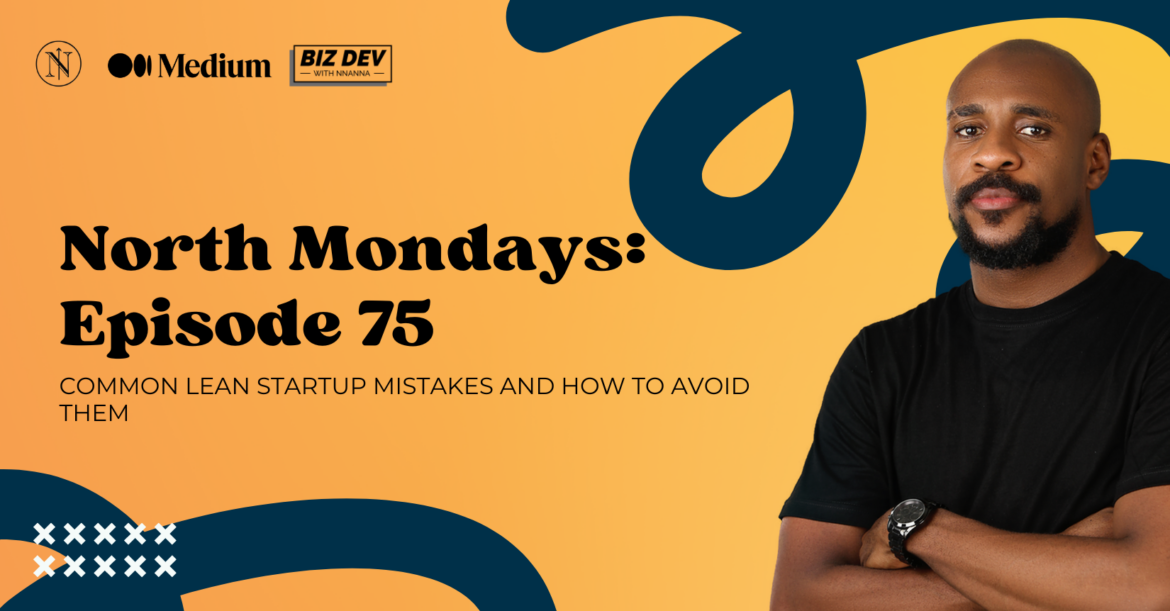Common Lean Startup Mistakes and How to Avoid Them
North Mondays Series: Episode 75

Are you an entrepreneur struggling to make the Lean Startup methodology work for your business? You’re not alone. Despite its popularity, many startups fail not because of bad ideas, but due to poor execution of Lean principles.
Imagine being able to identify and sidestep the most common Lean Startup pitfalls before they derail your business. By understanding these mistakes, you could save months of wasted effort, conserve precious resources, and significantly increase your chances of success.
In this episode of the North Mondays Series, I’ll walk you through the seven most critical Lean Startup mistakes I’ve observed in my years of mentoring entrepreneurs. You’ll learn not just what these mistakes are, but also receive practical, actionable strategies to avoid them. Whether you’re a first-time founder or a seasoned entrepreneur, these insights will help you build a more resilient, successful startup.
Ready to supercharge your Lean Startup implementation and take your business to the next level? Let’s dive in and transform the way you approach your entrepreneurial journey.
Introduction: The Lean Startup Challenge
The Lean Startup methodology has revolutionized how we approach building new businesses. It promises a path to sustainable business growth through rapid experimentation and iterative product releases. However, despite its apparent simplicity, many entrepreneurs struggle to implement these principles effectively.
In my years of mentoring startups, I’ve seen brilliant ideas falter not because of a lack of potential, but due to missteps in execution. Today, we’ll explore these common mistakes and provide actionable strategies to overcome them.
Mistake #1: Inadequate Customer Validation
One of the most critical errors in the Lean Startup process is skipping or rushing through customer validation. Entrepreneurs often fall in love with their solutions before verifying that there’s a real problem worth solving.
How to Avoid It:
- Conduct thorough customer interviews: Engage with your target audience early and often. Focus on understanding their problems, not selling your solution.
- Develop detailed user personas: Create comprehensive profiles of your target users based on real data and interviews. Understanding their motivations, behaviors, and pain points is crucial.
- Implement the “Problem Interview” technique: Before discussing your product, dig deep into the problem you’re trying to solve. Ask open-ended questions about how potential customers currently handle the issue.
- Use the “5 Whys” method: To get to the root of customer problems, repeatedly ask “Why?” to each answer. This helps uncover underlying issues that might not be immediately apparent.
Mistake #2: Overbuilding the Minimum Viable Product (MVP)
Many startups fall into the trap of adding too many features to their MVP, losing sight of its primary purpose: to test fundamental business hypotheses with minimal resources.
How to Avoid It:
- Focus on core functionality: Identify the one key feature that solves your customer’s primary problem. Build only what’s necessary to deliver that core value.
- Set strict MVP criteria: Establish clear guidelines for what constitutes your MVP. Anything that doesn’t directly contribute to testing your main hypothesis should be put on hold.
- Embrace imperfection: Remember, an MVP is meant to be a learning tool, not a perfect product. Be prepared to release something that might feel uncomfortably basic.
- Use the “Concierge MVP” approach: Consider manually delivering your service to early customers before building any technology. This can provide valuable insights with minimal investment.
Mistake #3: Misinterpreting Data
Data is crucial in the Lean Startup process, but misinterpreting it can lead to misguided decisions. It’s easy to see patterns where none exist or to overlook important trends.
How to Avoid It:
- Set clear success criteria: Before running experiments, define what success looks like in measurable terms. This prevents post-hoc rationalization of results.
- Practice data triangulation: Use multiple data sources and methods to verify your findings. Don’t rely solely on quantitative or qualitative data alone.
- Beware of confirmation bias: Actively seek out data that might disprove your hypotheses, not just confirm them. This helps ensure a more balanced interpretation.
- Implement regular peer reviews: Have team members or mentors review your data interpretation. Fresh eyes can often spot overlooked patterns or flaws in reasoning.
Mistake #4: Focusing on Vanity Metrics
Vanity metrics are measurements that make a company look good to others but do not help in understanding the company’s progress in terms of user experience or revenue. Examples include registered users, downloads, or raw pageviews.
How to Avoid It:
- Identify actionable metrics: Focus on metrics that drive business decisions. For a SaaS startup, this might include active users, customer lifetime value, or churn rate.
- Implement cohort analysis: Track how specific groups of users behave over time, rather than looking at aggregate data.
- Tie metrics to business goals: For each metric you track, clearly articulate how it relates to your key business objectives.
- Create a balanced scorecard: Develop a set of metrics that give a holistic view of your business, covering aspects like customer satisfaction, financial performance, and operational efficiency.
Mistake #5: Delayed Pivot Decisions
Knowing when to pivot or persevere is one of the hardest decisions for a startup. Many entrepreneurs stick with a failing strategy for too long, while others pivot too quickly without giving their ideas a fair chance.
How to Avoid It:
- Set clear pivot or persevere checkpoints: Establish specific milestones at which you’ll evaluate your progress and make strategic decisions.
- Use innovation accounting: Implement a system for measuring progress in the face of extreme uncertainty. This involves establishing learning milestones and prioritizing work to get the most learning for the least effort and expense.
- Conduct regular strategy reviews: Schedule monthly or quarterly sessions to step back and assess your overall direction. Use this time to honestly evaluate if you’re making progress towards product-market fit.
- Develop pivot criteria: In advance, define what conditions would necessitate a pivot. This helps remove emotion from the decision when the time comes.
Mistake #6: Perfectionism
In the Lean Startup world, perfectionism can be a significant hindrance. Striving for a perfect product before launch often leads to missed opportunities and wasted resources.
How to Avoid It:
- Embrace iterative development: Release early and often. Each iteration is an opportunity to learn and improve.
- Set time-boxed release cycles: Establish a regular cadence for releases, forcing prioritization of features and preventing endless tinkering.
- Adopt the “Good Enough” principle: For each feature, define the minimum level of quality that’s acceptable for release. Anything beyond that can wait for future iterations.
- Practice gradual rollouts: Use techniques like canary releases or A/B testing to gradually expose new features to users, allowing for real-world testing without the pressure of a “perfect” launch.
Mistake #7: Slow Learning Cycles
The essence of the Lean Startup methodology is to maximize learning in the shortest amount of time. Many startups fail to iterate quickly enough, losing valuable time and potentially their market advantage.
How to Avoid It:
- Implement rapid experimentation: Aim to run small, quick experiments weekly or even daily. The faster you can turn ideas into experiments, the more you’ll learn.
- Use MVP techniques for everything: Apply the MVP concept not just to your product, but to all aspects of your business – from marketing campaigns to hiring processes.
- Create a learning-focused culture: Encourage your team to prioritize learning over short-term success. Celebrate insights gained, not just positive outcomes.
- Streamline your build-measure-learn loop: Continuously look for ways to shorten the time between forming a hypothesis, testing it, and learning from the results.
Conclusion: Navigating the Lean Startup Journey
Avoiding these common mistakes can significantly increase your chances of success in implementing the Lean Startup methodology. Remember, the goal is to learn as much as possible about your customers and market with the least amount of time and resources expended.
As you navigate your startup journey, keep these lessons in mind. Be prepared to adapt, stay focused on your customers, and always prioritize learning. The path may not always be smooth, but by avoiding these pitfalls, you’ll be better equipped to handle the challenges that come your way.
Thank you for joining us for this episode of the North Mondays Series. Next week, we’ll be discussing effective bootstrapping strategies for early-stage startups. Until then, keep innovating and learning!
FAQs
How do you validate a product idea using Lean principles?
To validate a product idea, start by identifying the problem you’re solving, then engage in customer interviews and research to ensure there is a real need. Create an MVP, test it with your target audience, and gather feedback to refine your product or pivot if necessary.
What are common Lean Startup mistakes to avoid?
Common mistakes include skipping customer validation, overbuilding the MVP, misinterpreting feedback, focusing on vanity metrics, delaying the launch for perfection, and not learning fast enough. Addressing these can improve your chances of success.
What is the Lean Startup methodology?
Lean Startup is a methodology that focuses on rapid experimentation, customer feedback, and iterative development. It aims to reduce waste and improve the chances of success by testing assumptions early and adjusting based on real-world feedback.
How can I avoid overbuilding my MVP?
Focus on solving a single core problem with your MVP. Keep it simple and avoid adding unnecessary features. The goal is to test your key assumptions as quickly and affordably as possible.
How do I decide whether to pivot or persevere?
Base your decision on the feedback and data gathered from your MVP. If you’re not seeing the desired traction after several iterations, it may be time to pivot. If you’re seeing positive signs, continue refining your product and persevere.
By addressing these common Lean Startup mistakes, you can build a strong foundation for your business while learning quickly from your efforts. Join us next week for more insights in our North Mondays Series, and don’t forget to check out my online course, Biz Dev with Nnanna, for deeper guidance on growing your startup.
#LeanStartup #StartupMistakes #Entrepreneurship #NorthMondays #StartupSuccess #MVP #CustomerValidation #Innovation










Recent Comments